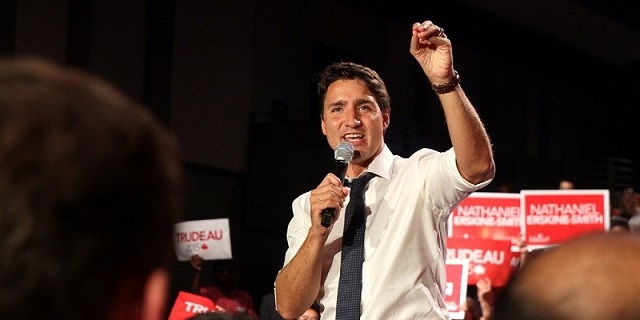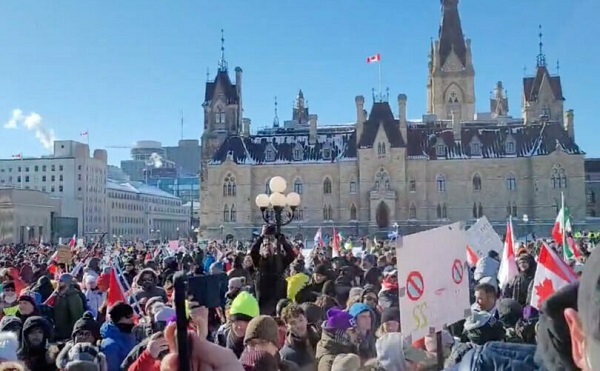Energy
Fossil fuel consumption rising despite ‘net-zero’ plans worldwide

From the Fraser Institute
By Julio Mejía and Elmira Aliakbari
During a recent speech in Brazil, U.S. Treasury Secretary Janet Yellen said that “many sources”—including governments—must spend “no less than $3 trillion” each year for the world to achieve “net-zero” global carbon emissions by 2050. While Yellen was light on specifics, she said the money would pay for “clean energy technologies” and “pathways to sustainable and inclusive growth.”
But to achieve net zero, which means either eliminating fossil fuel generation or offsetting the emissions generated through activities such as planting trees, countries must phase out the world’s primary energy source (fossil fuels such as oil and gas), defying the global trend of increasing fossil fuel consumption.
Indeed, between 1997 (when the original Kyoto Protocol was ratified) and 2023, the share of total global energy represented by fossil fuels declined slightly from 85.7 per cent to 81.5 per cent. However, during that same period the actual use of fossil fuels has increased dramatically with global consumption of coal, gas and oil increasing by 56 per cent.
Here in Canada, despite billions spent and almost a decade of new taxes and regulations in the Trudeau government’s pursuit of net zero by 2050, the share of fossil fuels in our total energy consumption increased from 64.6 per cent in 2015 to 65.0 per cent in 2023. Clearly, the Trudeau government’s carbon tax, regulations and policies meant to phase out fossil fuels have not achieved this goal.
But this comes as no surprise. Massive energy transitions are slow and take centuries. Renowned scholar Vaclav Smil’s recent study explained that the first global energy transition—from traditional biomass fuels (including wood and charcoal) to fossil fuels—started more than two centuries ago and unfolded gradually. In fact, the transition away from biomass fuels remains incomplete. Nearly three billion people in the developing world still depend on charcoal, straw and dried dung for cooking and heating, accounting for about 7 per cent of the world’s energy supply (as of 2020).
According to Smil, coal only surpassed wood as the main energy source worldwide around the year 1900. It took more than 150 years from its first commercial extraction for oil to reach 25 per cent of all fossil fuels consumed worldwide, reaching this milestone in the 1950s. And natural gas reached this threshold at the end of the 20th century, after 130 years of the industry’s development.
So, let’s look at what net-zero advocates are proposing in a different way. For the world to reach net zero by 2050, the amount of energy humanity must replace with new sources (e.g. wind, solar) is 23 times greater than the amount of energy the world used when the previous transition started in the 19th century. And governments want to achieve this unprecedented transition in less than one-eighth of the time of the previous transition.
While politicians worldwide talk about a great energy transition, fossil fuel consumption has only grown. And it’s the same story here at home. Clearly, achieving net zero by 2050 is neither realistic nor feasible.
Authors:
Automotive
Federal government should swiftly axe foolish EV mandate

From the Fraser Institute
Two recent events exemplify the fundamental irrationality that is Canada’s electric vehicle (EV) policy.
First, the Carney government re-committed to Justin Trudeau’s EV transition mandate that by 2035 all (that’s 100 per cent) of new car sales in Canada consist of “zero emission vehicles” including battery EVs, plug-in hybrid EVs and fuel-cell powered vehicles (which are virtually non-existent in today’s market). This policy has been a foolish idea since inception. The mass of car-buyers in Canada showed little desire to buy them in 2022, when the government announced the plan, and they still don’t want them.
Second, President Trump’s “Big Beautiful” budget bill has slashed taxpayer subsidies for buying new and used EVs, ended federal support for EV charging stations, and limited the ability of states to use fuel standards to force EVs onto the sales lot. Of course, Canada should not craft policy to simply match U.S. policy, but in light of policy changes south of the border Canadian policymakers would be wise to give their own EV policies a rethink.
And in this case, a rethink—that is, scrapping Ottawa’s mandate—would only benefit most Canadians. Indeed, most Canadians disapprove of the mandate; most do not want to buy EVs; most can’t afford to buy EVs (which are more expensive than traditional internal combustion vehicles and more expensive to insure and repair); and if they do manage to swing the cost of an EV, most will likely find it difficult to find public charging stations.
Also, consider this. Globally, the mining sector likely lacks the ability to keep up with the supply of metals needed to produce EVs and satisfy government mandates like we have in Canada, potentially further driving up production costs and ultimately sticker prices.
Finally, if you’re worried about losing the climate and environmental benefits of an EV transition, you should, well, not worry that much. The benefits of vehicle electrification for climate/environmental risk reduction have been oversold. In some circumstances EVs can help reduce GHG emissions—in others, they can make them worse. It depends on the fuel used to generate electricity used to charge them. And EVs have environmental negatives of their own—their fancy tires cause a lot of fine particulate pollution, one of the more harmful types of air pollution that can affect our health. And when they burst into flames (which they do with disturbing regularity) they spew toxic metals and plastics into the air with abandon.
So, to sum up in point form. Prime Minister Carney’s government has re-upped its commitment to the Trudeau-era 2035 EV mandate even while Canadians have shown for years that most don’t want to buy them. EVs don’t provide meaningful environmental benefits. They represent the worst of public policy (picking winning or losing technologies in mass markets). They are unjust (tax-robbing people who can’t afford them to subsidize those who can). And taxpayer-funded “investments” in EVs and EV-battery technology will likely be wasted in light of the diminishing U.S. market for Canadian EV tech.
If ever there was a policy so justifiably axed on its failed merits, it’s Ottawa’s EV mandate. Hopefully, the pragmatists we’ve heard much about since Carney’s election victory will acknowledge EV reality.
Daily Caller
Trump Issues Order To End Green Energy Gravy Train, Cites National Security


From the Daily Caller News Foundation
By Audrey Streb
President Donald Trump issued an executive order calling for the end of green energy subsidies by strengthening provisions in the One Big Beautiful Bill Act on Monday night, citing national security concerns and unnecessary costs to taxpayers.
The order argues that a heavy reliance on green energy subsidies compromise the reliability of the power grid and undermines energy independence. Trump called for the U.S. to “rapidly eliminate” federal green energy subsidies and to “build upon and strengthen” the repeal of wind and solar tax credits remaining in the reconciliation law in the order, directing the Treasury Department to enforce the phase-out of tax credits.
“For too long, the Federal Government has forced American taxpayers to subsidize expensive and unreliable energy sources like wind and solar,” the order states. “Reliance on so-called ‘green’ subsidies threatens national security by making the United States dependent on supply chains controlled by foreign adversaries.”
Dear Readers:
As a nonprofit, we are dependent on the generosity of our readers.
Please consider making a small donation of any amount here.
Thank you!
Former President Joe Biden established massive green energy subsidies under his signature 2022 Inflation Reduction Act (IRA), which did not receive a single Republican vote.
The reconciliation package did not immediately terminate Biden-era federal subsidies for green energy technology, phasing them out over time instead, though some policy experts argued that drawn-out timelines could lead to an indefinite continuation of subsidies. Trump’s executive order alludes to potential loopholes in the bill, calling for a review by Secretary of the Treasury Scott Bessent to ensure that green energy projects that have a “beginning of construction” tax credit deadline are not “circumvented.”
Additionally, the executive order directs the U.S. to end taxpayer support for green energy supply chains that are controlled by foreign adversaries, alluding to China’s supply chain dominance for solar and wind. Trump also specifically highlighted costs to taxpayers, market distortions and environmental impacts of subsidized green energy development in explaining the policy.
Ahead of the reconciliation bill becoming law, Trump told Republicans that “we’ve got all the cards, and we are going to use them.” Several House Republicans noted that the president said he would use executive authority to enhance the bill and strictly enforce phase-outs, which helped persuade some conservatives to back the bill.
-

 Business1 day ago
Business1 day agoWEF-linked Linda Yaccarino to step down as CEO of X
-

 Freedom Convoy2 days ago
Freedom Convoy2 days agoCourt Orders Bank Freezing Records in Freedom Convoy Case
-

 Crime2 days ago
Crime2 days agoTucker Carlson: US intelligence is shielding Epstein network, not President Trump
-

 Business1 day ago
Business1 day ago‘Experts’ Warned Free Markets Would Ruin Argentina — Looks Like They Were Dead Wrong
-

 Automotive1 day ago
Automotive1 day agoAmerica’s EV Industry Must Now Compete On A Level Playing Field
-

 International1 day ago
International1 day agoSecret Service suspends six agents nearly a year after Trump assassination attempt
-

 Business23 hours ago
Business23 hours agoCarney government should recognize that private sector drives Canada’s economy
-

 Bruce Dowbiggin23 hours ago
Bruce Dowbiggin23 hours agoThe Covid 19 Disaster: When Do We Get The Apologies?









